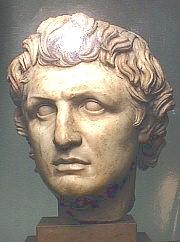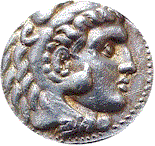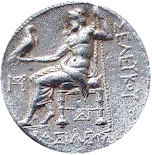Daring Macedonian general who
aided Alexander's
conquest of Persia & northern India & eventually united most of
Alexander's Asian empire [except for Palestine] under his
own rule. Just Alexander's junior, Seleucus earned the respect of the
conqueror & older officers for his performance in the Indian
campaigns. So, when Perdiccas was named
regent after Alexander's death (323
BCE), he made the energetic young
general his viceroy [chiliarchos]. Yet when Perdiccas' troops
mutinied during his invasion of Egypt, Seleucus restored order by joining
other aides [Peithon & Antigenes] in assassinating their commander (321
BCE). When the regional governors redivided the Macedonian
empire, Seleucus replaced Perdiccas as satrap
[governor] of Babylonia.
Yet he was unable to secure his
realm against the expansionist plans of Antigonus.
In 316
BCE Seleucus abandoned Babylon & sought refuge with Ptolemy, leaving
Antigonus free to annex almost all of Asia (316
BCE). But in the
next coalition war he took his revenge. Though reduced to the rank of
naval commander in Ptolemy's service, Seleucus plundered Antigonus' coastline,
reclaimed Cyprus & joined forces with his host in defeating Antigonus'
son, Demetrius, at Gaza (312
BCE). Then, turning East with a small
contingent, he reclaimed Babylon without a fight & defeated the
remaining Antigonid allies in Asia. After the truce of 311
BCE Seleucus
was left as master of most Asian provinces with the notable exception of
Phoenicia & Palestine, which
Ptolemy had annexed in his ally's absence.
But the former exile was not
content with a triumphant return. In 305
BCE he, like other Hellenistic rulers, took
the title of basileus ["king"] to counter Antigonus'
royal pretensions. Then he came to the aid
of Lysimachus
in defeating Antigonus at the battle of Ipsus (301
BCE). In the division of spoils, Seleucus claimed all of Syria &
the eastern provinces of Asia Minor. To solidify the control of his
prize Mediterranean territories, he transferred his capital from Seleucia on the Tigris
to the new city of Antioch [named for his father] on the Orontes in
northwestern Syria (293
BCE), leaving his son,
Antiochus,
to rule the eastern provinces.
For almost two decades Seleucus
was able to concentrate on consolidating his hold on his vast kingdom,
bothered only by the few forces still loyal to the Antigonid cause now led
by Demetrius. But in 282
BCE he was unexpectedly drawn into the
family feud of his neighbor & former ally, Lysimachus, whose wife,
Arsinoë,
had convinced him to execute his oldest son by a former marriage on
trumped up charges of treason. When the dead man's wife [Lysandra]
& children sought refuge in Seleucus' court, he championed their cause
by invading Lysimachus' domain. When the two septuagenarians met at Corupedium [in
western Asia Minor] -- in rumored hand-to-hand combat -- Lysimachus was
killed (281
BCE), leaving Seleucus the last survivor of Alexander's
generals & the ruler of his whole Asian empire from the Bosporus to
the Hindu Kush.
But with Lysimachus, the ruler
of Thrace & Macedonia, gone another prize loomed on the horizon.
Seleucus now had a chance to achieve a goal that had eluded all of his
former comrades in arms: the reunification of all of Alexander's empire.
So, instead of pausing to consolidate his conquest of Asia Minor, the old
warrior launched an invasion of Europe. But before he could reach his
homeland, he was killed -- not by opposing forces but by a guest in his
own camp: Ptolemy's son Ceranus, who had been exiled by his
brother,
Ptolemy II Philadelphus. No motive was ever discovered for this
assassination. But there is historical irony & poetic justice in the
fact that Seleucus' rise to power, which was launched by his unanticipated
assassination of Perdiccas ended in his own unanticipated
assassination. His ashes were enshrined by his son
Antiochus I at
Seleucia, where he was worshipped posthumously as Zeus Nicator, an
incarnation of the head of the Greek pantheon.
References:
Josephus,
Antiquities
12.2,119,125,246,363; 13:213,267.
_____, Against Apion 2.39.
Appian, Roman History
11.55-63.
Justin, Epitome
15.4;
17.1-2.
Pausanias, Description
of Greece
1.6.4, 10.2-5.
Other resources on line:


![]()
![]()


![]()
![]()
![]() Perspective on the
World of Jesus
Perspective on the
World of Jesus ![]()